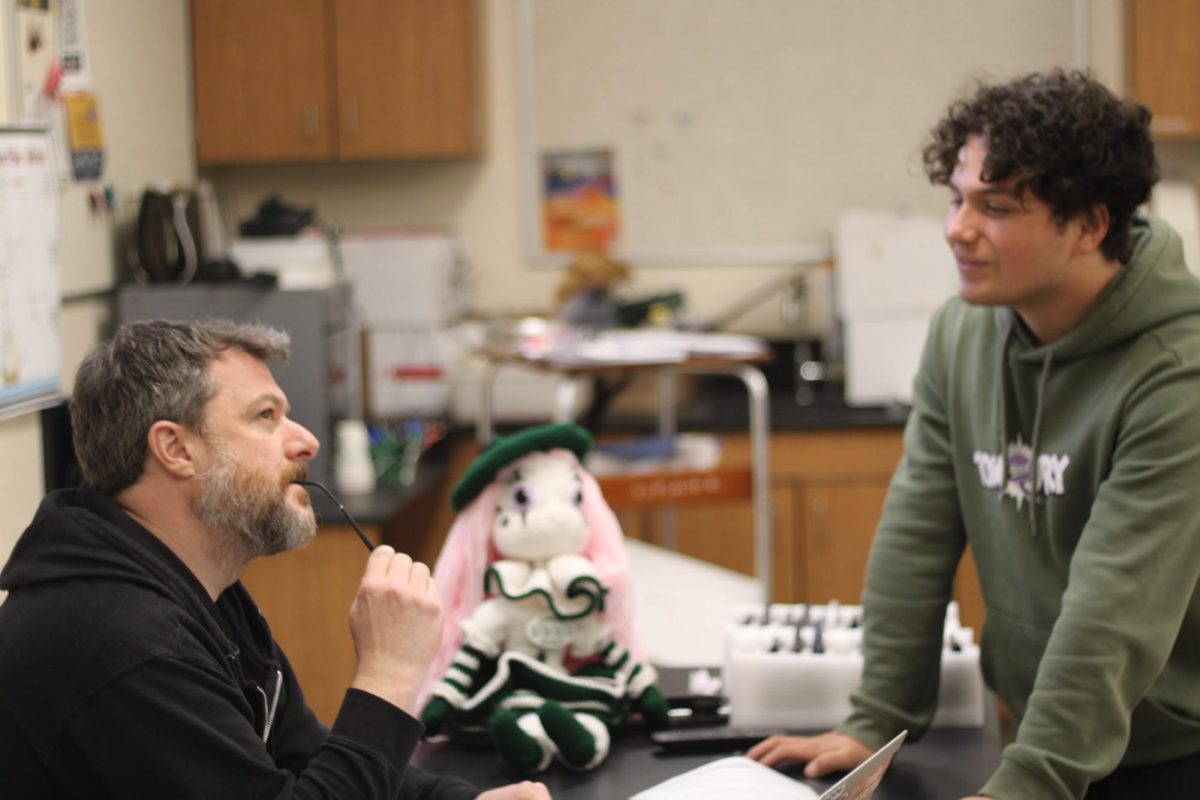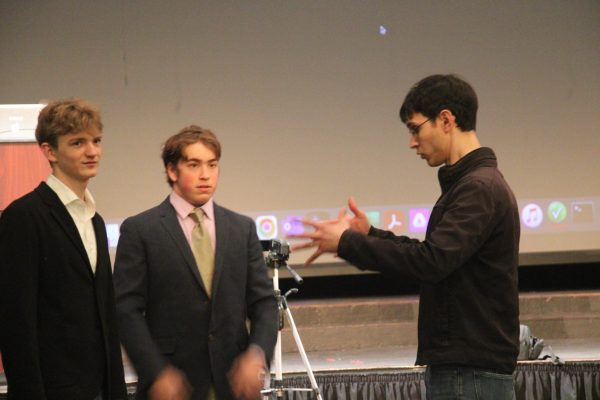
Arjun Jindal
Michael Lupoli reviews senior Jose Pinto Saldana’s AAR draft and gives insight. “You’re essentially doing one project all year long,” Lupoli said. “And you’re updating it, you’re adding parts to it throughout the year and we coach people through that and give people direction and guidance.”
Two classrooms around campus are filled with open laptops, yet no two screens are the same. While this may sound like a study hall, in rooms 1702 and 1707, students in the research pathway aren’t studying for a new test, but instead, they are each creating their own unique test questions, guidelines, and lessons through individual processes.
From science labs to social justice papers, research is at the heart of any advanced level of study, promoting progress in various fields. To prepare students for post Paly life, the school offers two research paths, Advanced Authentic Research , a one-year, dual-enrolled course, and AP Research following AP Seminar, a two-year capstone program. For the first time, both AP research and AAR are being taught by teachers with science backgrounds: Michael Lupoli and Samuel Howles-Banerji.
Lupoli has taught nearly every science course that Paly has to offer including Biology, Chemistry, Physics, Astrophysics, and Marine Biology. Meanwhile, Howles-Banerji has spent the majority of his time at Paly teaching Chemistry.
AP Capstone is a nationally recognized program that begins with building critical reading, writing, and thinking skills in AP Seminar and then developing personal research with those skills in AP Research. During AP research, students explore an unanswered question and design a study to answer the question.
 Samuel Howles-Banerji assists seniors Otto Kiss Meyerfreund and Jack Madwed in leading their AP Research preseentations. “I’m interested in what my students are doing,” Howles-Banerji said. “Because I’ve been talking to them about it all year, I can’t can’t help but to get interested in it.” (Vivian Tang)
Samuel Howles-Banerji assists seniors Otto Kiss Meyerfreund and Jack Madwed in leading their AP Research preseentations. “I’m interested in what my students are doing,” Howles-Banerji said. “Because I’ve been talking to them about it all year, I can’t can’t help but to get interested in it.” (Vivian Tang)
“AP research is a very open-ended course where it’s entirely student-driven,” Howles-Banerji said. “Everybody’s working on their own research.”
Their research includes going out and collecting their own data. While not all projects are science-based, this is still very similar to the science field.
“It’s not just doing research and not just gathering other papers,” Howles-Banerji said. “It’s generally more of ‘okay, well, nobody has quite answered the question from this perspective, so I’m going to create a study to answer this new question that nobody has asked.’”
Senior Maxwell Akash Tuteja is working on a project in AP Research regarding acoustic physics and technology.
“Although AP Research doesn’t offer explicit laboratory tools or equipment, it sets you up for independent study,” Tuteja said. “We’ve spent class time discussing the feasibility of our various projects and how we’re going to get the resources to accomplish them.”
If students want to perform lab work in AP Research, that would need to be done through outside connections, however, it is possible to build and test the technology at home.
“Often if a student is going to want to do research that involves more laboratory science, they’re probably gonna need a professional,” Howles-Banerji said.
Meanwhile, AAR answers unanswered questions by analyzing published papers and drawing conclusions from combining sources.
“What [they] [have] to do is look at published literature that already exists and look at data sets other researchers have collected and analyzed that data,” Lupoli said.
If current Advanced Authentic Research students want to have access to laboratory equipment, they have to undergo the same process of reaching out to external labs as AP Research. Lupoli hopes to change the program to include more opportunities for STEM through making laboratories more accessible and providing more information on STEM research in the course.
“In reality, we tend not to do too much lab work for this class,” Lupoli said. “But I hope to actually change that in future years.I’d like to expand that aspect of the program. I’d like to find ways to use the lab equipment and materials we have here at school. Better for our students.”
Both programs aim to make a larger impact in their community through their findings and research questions. For example, senior Katie Bradley is working on a project in AAR between the gender divide in STEM fields.
“I hope my project sheds light on some potential reasons why more girls don’t take AP Physics C at Paly,” Bradley said.
In his AP Research project, senior Graeme Kieran aims to shape public policy through his new research in public opinion on AI surveillance, an up and coming field. To achieve this, he is working on code independently.
“What I wanna do is I wanna judge the public opinion on human reviewers versus AI reviewers in order to drive policy,” Kieran said. “ One of the biggest concerns that we’re seeing is ethics. And so, I want to see if I can get a more nuanced perspective on public opinion to create ethical suggestions for policy.”
Both classes are collaborative, enjoyable, and leave room for freedom of thought. However, AAR is the path looking to open up more opportunities for STEM-based projects. To do so, Lupoli is looking for students interested in science to join his class.
“It’s typically been teachers and the humanities teaching AAR, which is great, and there are plenty of people who do research subjects in the humanities,” Lupoli said. “But I would like to get more science-minded students in AAR doing science-related projects.”